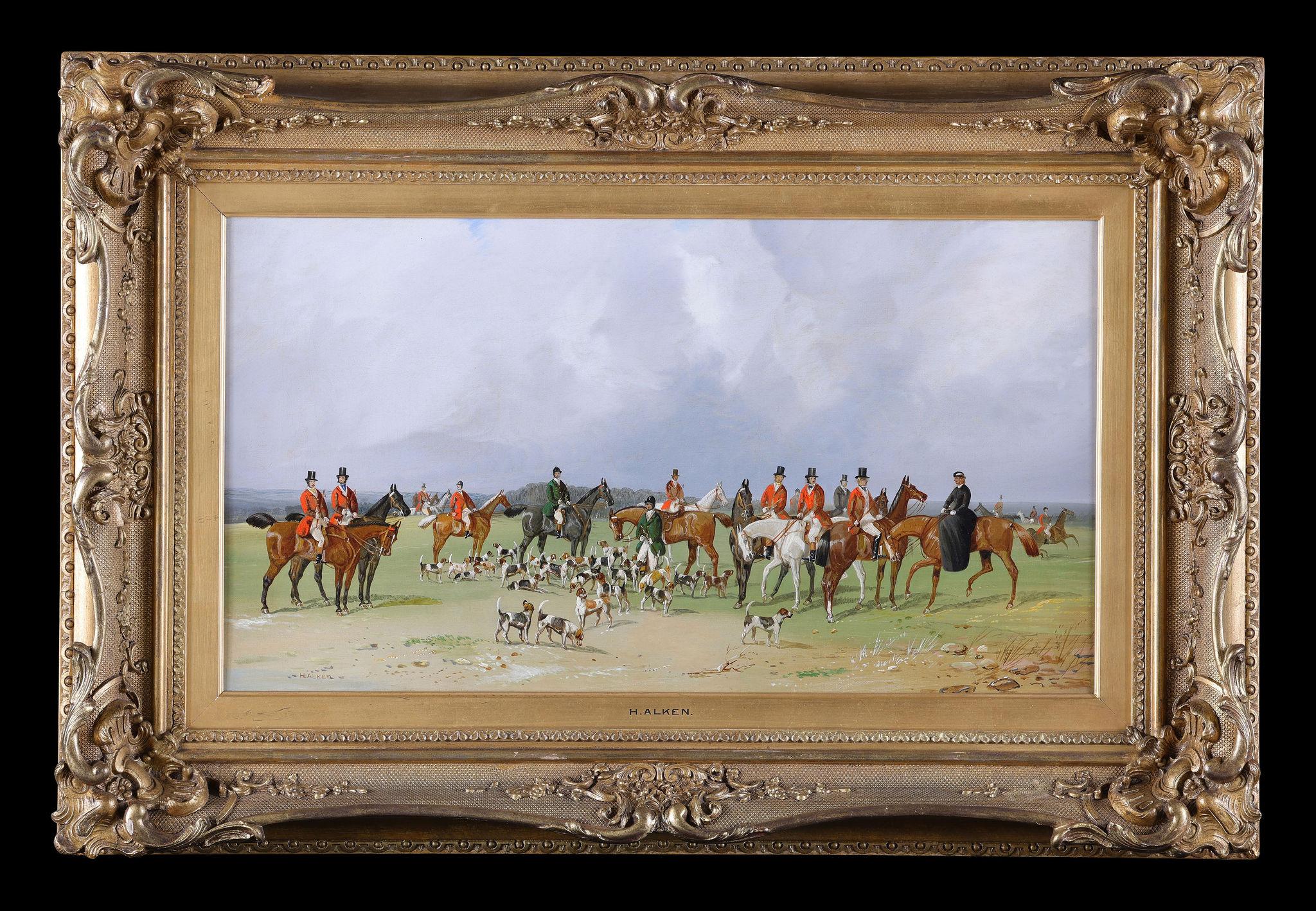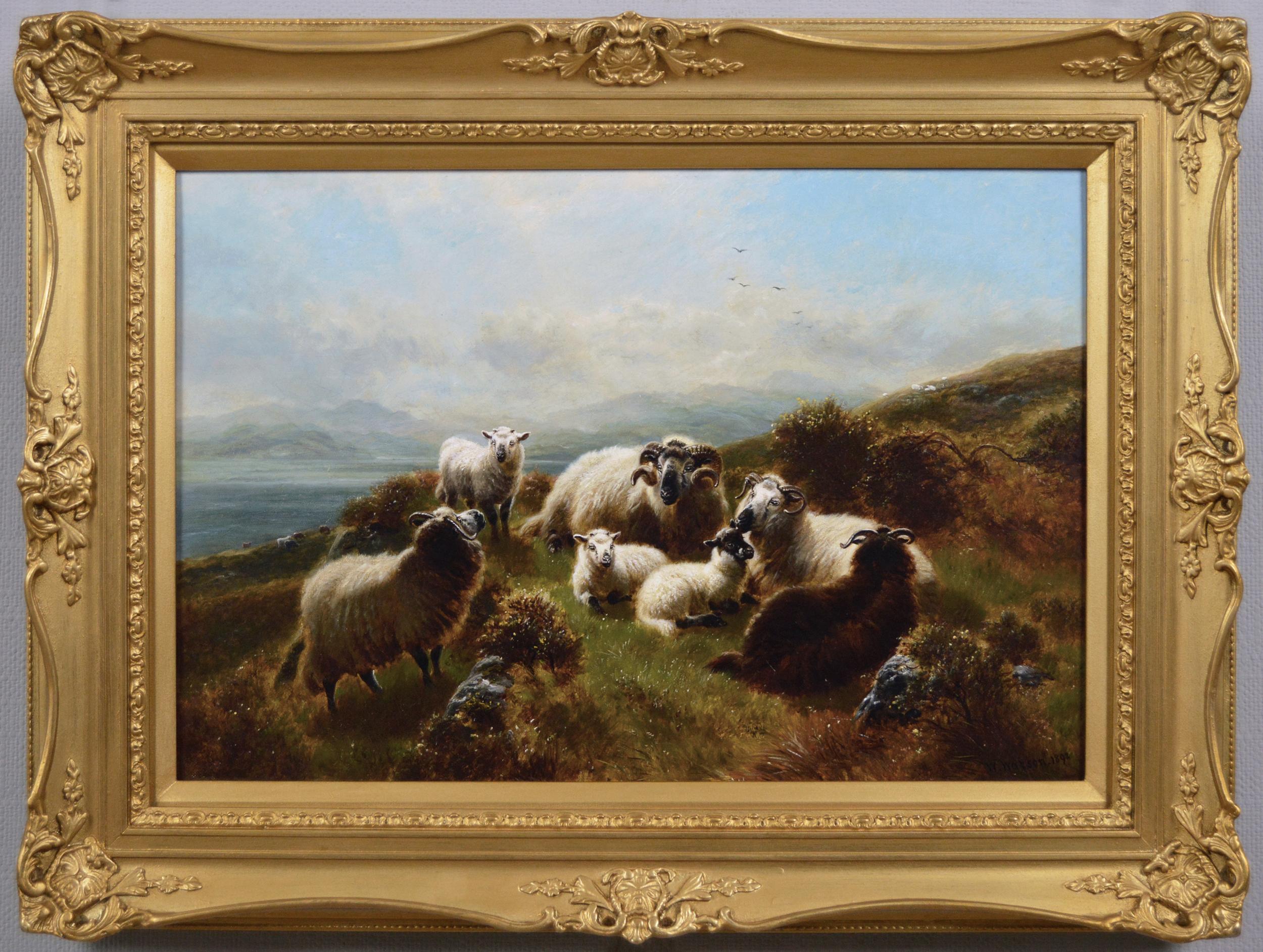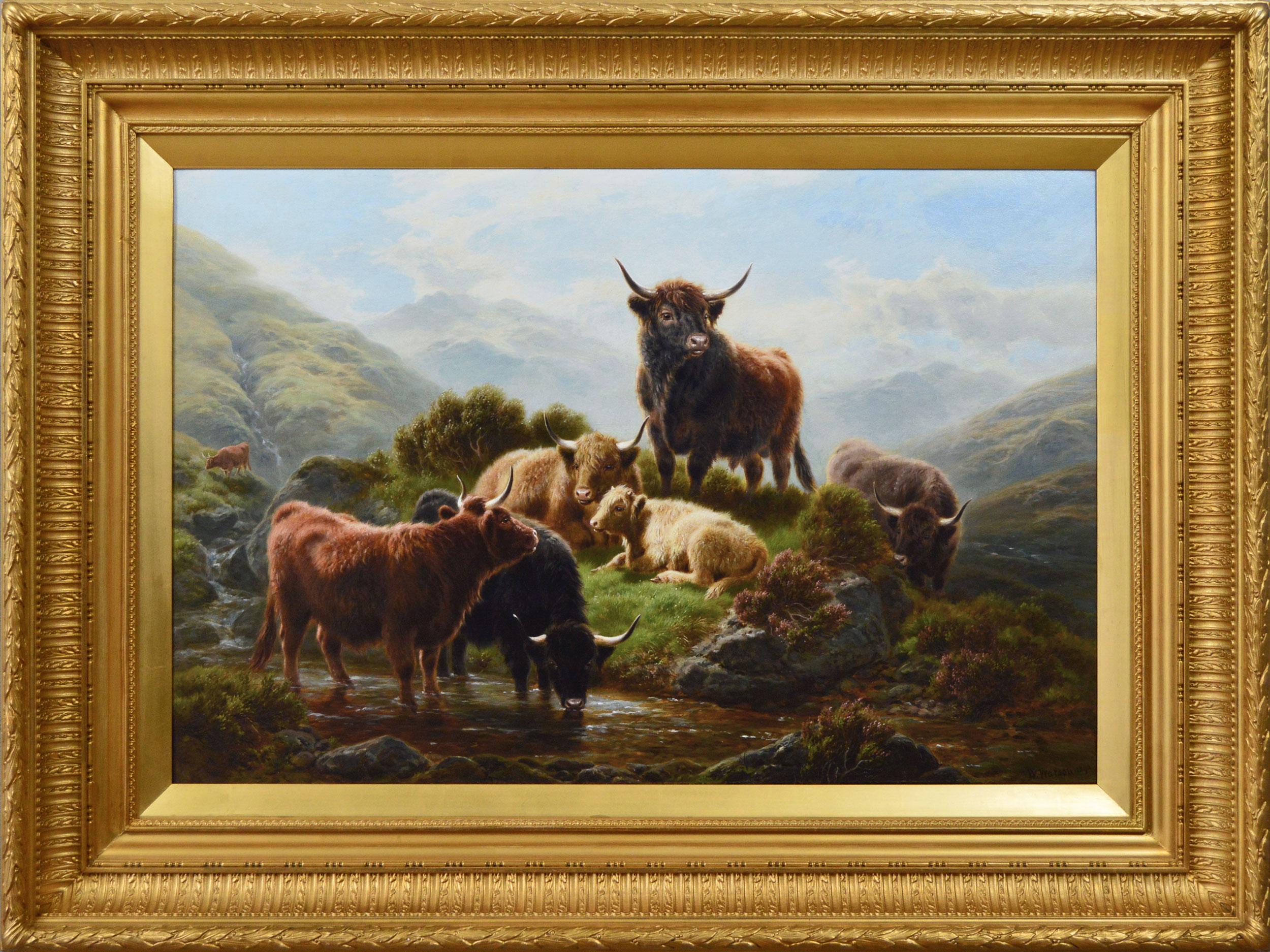Items Similar to On the Way to Work
Want more images or videos?
Request additional images or videos from the seller
1 of 10
Henry H ParkerOn the Way to Work
About the Item
HENRY H. PARKER - 1858 - 1930
Canvas Size: 12 x 24" (30 x 60cm)
Outside Frame Size: 19 x 31" (48 x 78cm)
A traditional image that Parker often painted. The piece is fully signed in the bottom left.
Born in 1858, Henry H. Parker was a British artist working at the end of the Victorian Era. It is believed that he was born and lived in London where he studied at the St Martin's School of art. He started his working life as an illustrator for the Illustrated London News, and by the age of 23 had become known as a Landscape painter. His landscapes are lush and tranquil, frequently featuring a loan figure in a boat or walking down a country path. The scenes are often sunny and bright and the waters are calm and soothing.
His style shows a great influence by the Impressionists, through his use of bright colours and quick brush strokes, but a definite understanding of the Academic principals is also displayed. This style of painting was very typical for the late Victorian landscape artists who strove to incorporate the new Impressionist techniques in their more traditional paintings. His landscapes and skies were created with a free, but controlled, application of paint while the watery areas of his work were handled in the more traditional way - using glazes to create depth and reflections. His paintings are well composed, beautifully balanced and capture the landscape in its most pure and natural state. This colourful and free look was a welcome relief to the traditional Victorian landscapes of the previous decades and this, coupled with Parker's choice of subject matter, brought him great success. He painted mainly in the South East of England, in Surrey, Sussex, and along the Thames where he frequently stayed at Goring and Streatley. He also painted in the Worcestershire area and in Wales. He would often sign and title his works, with their exact location, on the reverse.
Throughout his life he enjoyed widespread popularity as an artist, and this is today witnessed by the number of his works consigned to Galleries and Museums throughout the world. From 1923, Parker exhibited in the United States, especially in Chicago, where he was unable to meet the demand for his pictures. His paintings were also popular with the Canadians and were hung in all the leading clubs throughout Canada and the States.
Of final note, it is very interesting that Parker was one of only a handful of artists, of his calibre, to never exhibit at the major exhibition halls in England during his lifetime and whose popularity has increased over the years.
Parker's works can be found in the following museums and galleries:-
England: Birmingham, Liverpool, Eastbourne, Hartlepool, Bradford.
Canada: The Manitoba Club, Winnipeg, St James's, Montreal.
New Zealand: The Auckland Museum
Australia: The Melbourne Gallery
It has benefited from a light clean and a reline.
- Creator:Henry H Parker (1858 - 1930)
- Dimensions:Height: 19 in (48.26 cm)Width: 31 in (78.74 cm)Depth: 3 in (7.62 cm)
- Medium:
- Movement & Style:
- Period:
- Condition:
- Gallery Location:St. Albans, GB
- Reference Number:1stDibs: LU2469214043632
About the Seller
5.0
Gold Seller
These expertly vetted sellers are highly rated and consistently exceed customer expectations.
Established in 1965
1stDibs seller since 2023
19 sales on 1stDibs
Typical response time: 2 hours
- ShippingRetrieving quote...Ships From: St. Albans, United Kingdom
- Return PolicyA return for this item may be initiated within 7 days of delivery.
More From This SellerView All
- The Hunt RestingBy Henry AlkenLocated in St. Albans, GBHenry Thomas ALKEN 1785 – 1851 A very typical example of Alken's work in a beautifully presented original antique frame. Alken's work is highly collectable and this is worthy of any...Category
1840s Victorian Landscape Paintings
MaterialsOil
- Jamey - A Brindle Scottie TerrierBy Wright BarkerLocated in St. Albans, GBWright BARKER Exhibited 1885 - 1935 Canvas Size: 20 x 26" (50 x 65cm) Outside Frame Size: 29 x 35" (72.5 x 87.5) He was a figure and animal painter who was based originally in Brad...Category
Early 1900s Victorian Animal Paintings
MaterialsOil
- Three horses and a FoalBy Wright BarkerLocated in St. Albans, GBWright BARKER 1864 - 1941 Canvas Size: 27 x 40" (69 x 102cm) Outside Frame Size: 33 x 46" (84 x 117cm) Oil on Canvas Free Shipping Exhibited : 1885 - 1935 He was a figure and anim...Category
Early 1900s Victorian Animal Paintings
MaterialsOil
- Cattle Grazing Near Rhyl, North WalesLocated in St. Albans, GBA stunning, showpiece example of William Henry Mander's painted in Rhys, North Wales. The size is unusual and perfect for a mantlepiece as a statement piece. Picture Size: 22 x 36" ...Category
1880s Victorian Landscape Paintings
MaterialsOil
- On The ChaseBy Henry AlkenLocated in St. Albans, GBHenry Thomas ALKEN 1785 – 1851 A very typical example of Alken's work in a beautifully presented original antique frame. Alken's work is highly collectable and this is worthy of any...Category
1840s Victorian Landscape Paintings
MaterialsOil
- Ben-Venue and Ben-A'anBy Alfred de Breanski Sr.Located in St. Albans, GBAlfred De Breanski Senior Oil on canvas Signed and inscribed on the reverse Canvas Size: 24 x 36" (60 x 90cm) Outside Frame Size: 35 x 47" (87.5 x 117.5cm) Free shipping worldwide ALFRED De BREANSKI Snr Alfred De Breanski was a distinguished landscape painter who became famous for his resplendent views of the Welsh and Scottish Highlands; he also painted many views of the Thames. Often bathed in a flood of golden light, these landscapes usually feature water and cattle or sheep on grassy banks; sometimes a solitary figure is seen the distance. Breanski belonged to the real stamp of those landscape painters who nimbly seized moments of the day. He had a great passion for the Highlands and perhaps more than any other, caught the atmospheric influences of the undulating landscape. Born in Greenwich...Category
1870s Victorian Landscape Paintings
MaterialsOil
You May Also Like
- 19th Century exhibition size landscape oil painting of Sheep on a cliffBy Charles Jones (b.1836)Located in Moreton-In-Marsh, GloucestershireCharles Jones British, (1836-1892) Sheep Resting Oil on canvas, signed with monogram & dated 1877, further inscribed verso Image size: 35 inches x 59 inches Size including frame: 47 inches x 71 inches Exhibition Size Painting A fantastic exhibition sized landscape painting of sheep on a cliff top by the coast by Charles ‘Sheep’ Jones. At the time he produced this painting, Jones was living at Heathercroft, Balham Hill in London. Given the size and quality of the work it was most likely an exhibition piece. The topography and landscape suggest that this is the Dorset coast, one of his favourite places to paint. Charles Jones was an animal painter who was born in Stepney, London in 1836. He was the son of the artist Samuel John Egbert Jones (1797-1861) and Dinah Jones. He lived with his parents and 9 siblings in Mile End and was a pupil of his father. In September 1859, he married Frances Rosalinda Downe, who was born in America. His son Arthur Bertram Loud (1863-1930) also became an artist. They lived at 12 Hayes Place, Lisson Grove from where he made his debut in London at the Royal Academy in 1861. He also exhibited at the British Institution, Suffolk Street, New Watercolour Society, Royal Institute of Oil Painters and the Royal Institute of Painters in Watercolours. By 1867, he had become a successful artist and they had moved to 7 Paragon Place, Brixton Hill. From 1874 he lived at Heathercroft, Balham Hill where he spent the rest of his life. Jones became well known for specialising in paintings of sheep, cattle and deer in landscape settings. He spent his time travelling around visiting areas such as Devon, Dorset, Kent, Sussex and the Highlands. However, it is for his skilful painting of sheep that he is perhaps best known, and for which earned him the nickname of ‘Sheep’ Jones. As well as the major London galleries, he also exhibited provincially at various locations including: the Royal Cambrian Academy where he was elected a member in 1886, the Glasgow Institute of Fine Arts, Manchester City Art Gallery, Royal Hibernian Academy, Royal Society of British Artists, Birmingham and the Walker Art Gallery, Liverpool. Some of the smaller more intimate galleries he exhibited at were Arthur Tooth & Sons and Thomas...Category
19th Century Victorian Animal Paintings
MaterialsCanvas, Oil
- 19th Century Highland landscape oil painting of sheep near Loch AweLocated in Moreton-In-Marsh, GloucestershireWilliam Watson Jnr British, (1847-1921) On the Mountains, Loch Awe Oil on canvas, signed & dated 1892, further inscribed verso Image size: 12.5 inches x 18.5 inches Size including frame: 18.5 inches x 24.5 inches A wonderful painting of Highland sheep resting near Loch Awe by William Watson Jnr. Loch Awe is located in Argyll and Bute in the Scottish Highlands and this scene is taken from the mountain side overlooking the loch. William Watson was born in Islington in 1847, the son of the London miniature painter William John Watson (1810-1871) and his wife Caroline (née Butcher). His brothers Charles Watson (1837-1900) and Robert Watson (1855-1921) were also artists. His father seems to have travelled around and after spending time in Brighton, the family moved to Bransford Road in Worcester during the early part of the 1860’s. As well as being taught by his father, Watson received his early training in the studio of Sir Francis Grant PRA (1803-1878). He later became a pupil of Sir Edwin Henry Landseer RA (1802-1873) and Rosa Bonheur (1822–1899). Both Landseer and Bonheur had a great influence on his work and he began specialising in scenes of cattle and sheep. By 1866 he had become a full time artist and began exhibiting at the Royal Society of British Artists. Perhaps to take advantage of the inspiring scenery, Watson moved to Birkenhead, Cheshire where in 1871 he met and married Eleanor Davies who was from Caernarvonshire. Four of their children Sidney Watson (1881-1931), Caroline Ellen...Category
19th Century Victorian Animal Paintings
MaterialsCanvas, Oil
- Pair of landscape hunting scenes with wild boarLocated in Moreton-In-Marsh, Gloucestershire**PLEASE NOTE: EACH PAINTING INCLUDING THE FRAME MEASURES 17 INCHES X 20 INCHES** Godfrey Douglas Giles British, (1857-1941) Wild Boar & her Young in an Indian Landscape & Pursuit o...Category
Early 20th Century Victorian Animal Paintings
MaterialsOil, Panel
- 19th Century Scottish landscape oil painting of a figure with Highland CattleBy Henry GarlandLocated in Moreton-In-Marsh, GloucestershireHenry Garland British, (1834-1913) Driving the Cattle ‘Hame’ Oil on canvas, signed & further inscribed & dated 1895 verso Image size: 32.25 inches x 27.25 inches Size including fram...Category
19th Century Victorian Animal Paintings
MaterialsOil, Canvas
- 19th Century Scottish landscape oil painting of Highland cattle at Glen GoilBy William WatsonLocated in Moreton-In-Marsh, GloucestershireWilliam Watson Jnr British, (1847-1921) Up Glen Goil, West Highlands Oil on canvas, signed & dated 1892, further inscribed verso Image size: 23.5 inches x 35.5 inches Size including frame: 36.25 inches x 48.25 inches This highly atmospheric and well executed painting by William Watson Jnr depicts Highland Cattle watering at Glen Goil. Glen Goil is a valley area of Argyll and Bute in the West Highlands. It is situated at the junction of Hell’s Glen and Gleann Mor and has the river Goil flowing through. Located around 2 miles from Lochgoilhead, it is well known as an area of outstanding natural beauty. Watson made several trips to the Highlands and produced a number of paintings of the locality, many of which included highland cattle such as this fine example. Another painting by him of Glen Goil is held by the Walker Art Gallery, Liverpool. William Watson was born in Islington in 1847, the son of the London miniature painter William John Watson (1810-1871) and his wife Caroline (née Butcher). His brothers Charles Watson (1837-1900) and Robert Watson (1855-1921) were also artists. His father seems to have travelled around and after spending time in Brighton, the family moved to Bransford Road in Worcester during the early part of the 1860’s. As well as being taught by his father, Watson received his early training in the studio of Sir Francis Grant PRA (1803-1878). He later became a pupil of Sir Edwin Henry Landseer RA (1802-1873) and Rosa Bonheur (1822–1899). Both Landseer and Bonheur had a great influence on his work and he began specialising in scenes of cattle and sheep. By 1866 he had become a full time artist and began exhibiting at the Royal Society of British Artists. Perhaps to take advantage of the inspiring scenery, Watson moved to Birkenhead, Cheshire where in 1871 he met and married Eleanor Davies who was from Caernarvonshire. Four of their children Sidney Watson (1881-1931), Caroline Ellen Watson (1871-1947), William Robert Charles Watson (1873-1928) and Walter James Watson...Category
19th Century Victorian Animal Paintings
MaterialsCanvas, Oil
- 19th Century landscape animal oil painting of Highland Cattle on a moorBy Louis Bosworth HurtLocated in Moreton-In-Marsh, GloucestershireLouis Bosworth Hurt British, (1856-1929) Crossing the Moorland Oil on canvas, signed & inscribed with title in pencil on the stretcher Image size: 23.5 inches x 39.25 inches Size in...Category
19th Century Victorian Animal Paintings
MaterialsCanvas, Oil





